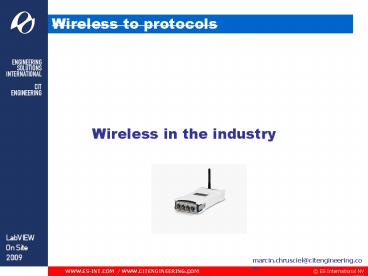Wireless to protocols - PowerPoint PPT Presentation
1 / 15
Title:
Wireless to protocols
Description:
... ppt/presentation.xml ppt/s/12.xml ppt/s/6.xml ppt/s ... image1.png ppt/media/image2.png ppt/media/image3.png ppt/notesMasters/_rels ... – PowerPoint PPT presentation
Number of Views:139
Avg rating:3.0/5.0
Title: Wireless to protocols
1
Wireless to protocols
Wireless in the industry
marcin.chrusciel_at_citengineering.com
2
- Agenda
- Why everybody wants to go wireless?
- Which standards are really available today?
- 802.15.4 ZigBee MAC
- 802.11b/g
- What are the limitations
- Conclusion
3
- Why everybody wants to go wireless?
- Who is everybody?
- It is cheaper
- It is flexible
- It is cool
- All above is the truth but only in the consumer
electronics area
It is rather hard to find a hardware
engineer who would prefer wireless connection
instead of wired one
Wire is wire you know.
4
- Why everybody wants to go wireless?
5
- Why everybody wants to go wireless?
6
- Pragmatic point of view
7
- 802.15.4 ZigBee MAC
- ZigBee is still not freely present in consumer
electronics market - What is special and worth to notice MAC
- Direct Dequence Spread Spectrum (DSSS) - very
powerfull mechanism - Each byte divided into two symbols. Each symbol
is mapped to one out of 16 pseudo-random
sequences, 32 chips each. The chip sequence is
then transmitted at 2 MChips/s. (for 2.4GHz IF)
Efectivelly -gt 250kbit/s
- And what about the protocol?
- Texas Instruments SimpliciTI protocol
- Michrochip MiWi protocol
8
- MiWi
MiWi and MiWi P2P are proprietary protocol
stacks developed by Microchip for short-range
wireless networking applications based on the
IEEE 802.15.4 wireless personal area network
(WPAN) specification. The MiWi protocol stacks
offer a small foot-print alternative to the
standard based ZigBee compliant protocol stack
and are optimized for low-power, low data rate,
cost sensitive application.
Lowest-cost fully functional network protocol for
IEEE 802.15.4 transceivers Ultra small
memory footprint proprietary protocols
Simple, low cost solution for customers who do
not need interoperability with other ZigBee
devices No Fees or certification required
9
- SimpliciTI
SimpliciTI is a simple low-power RF network
protocol aimed at small RF networks. Such
networks typically contain battery operated
devices which require long battery life, low data
rate and low duty cycle and have a limited number
of nodes talking directly to each other or
through an access point or range extenders.
Access point and range extenders are not required
but provide extra functionality such as store and
forward messages. With SimpliciTI the MCU
resource requirements are minimal which results
in the low system cost.
10
- Hart
HART Communication is a bi-directional industrial
field communication protocol used to communicate
between intelligent field instruments and host
systems. HART is the global standard for smart
process instrumentation and the majority of smart
field devices installed in plants worldwide are
HART-enabled. The global installed base of
HART-enabled devices is the largest of all
communication protocols at more than 20 million.
HART technology is easy to use and very reliable.
11
- Wireless Hart
WirelessHART uses the unlicensed part of the
radio spectrum in the 2.4GHz ISM band. As such,
it could be subject to interference from several
other sources, e.g. other networks or two-way
radios. To solve this problem WirelessHART "hops"
across 15 frequency channels sending each message
on a pseudo-random frequency.In addition,
WirelessHART uses proven IEEE 802.15.4 Direct
Sequence Spread Sprectrum (DSSS) radios that have
inherently good noise immunity. Spread spectrum
combined with frequency hopping combine two
proven ways to sidestep interference and overcome
interference with agility rather than brute
force. WirelessHART utilizes IEEE 802.15.4-2006
radios. IEEE 802.15.4 is unique in that it
provides good performance and low-cost and
interoperable radios are available from several
tier-one semiconductor manufacturers. IEEE
802.15.4 standard is also utilized by other
wireless standards which should allow for
continued innovation, cost reductions, and
support from major radio vendors.
12
- 802.11b/g
- Well know standard
- Easy to use, easy to extend
- OFDMThe primary advantage of OFDM over
single-carrier schemes is its ability to cope
with severe channel conditions for example,
attenuation of high frequencies in a long copper
wire, narrowband interference and
frequency-selective fading due to multipath
without complex equalization filters. Channel
equalization is simplified because OFDM may be
viewed as using many slowly-modulated narrowband
signals rather than one rapidly-modulated
wideband signal. The low symbol rate makes the
use of a guard interval between symbols
affordable, making it possible to handle
time-spreading and eliminate intersymbol
interference (ISI). This mechanism also
facilitates the design of single-frequency
networks, where several adjacent transmitters
send the same signal simultaneously at the same
frequency, as the signals from multiple distant
transmitters may be combined constructively,
rather than interfering as would typically occur
in a traditional single-carrier system.
13
- Who likes 802.11b/g
- National Instruments
- first wireless standard used in NI products
- Advantech
- Moxa
- .
14
- Limitations of wireless
- Real-Time synchronization
- Range
- Reliability
- Security
15
- Comments, questions, issues, problems?
- Thank you for your attention































